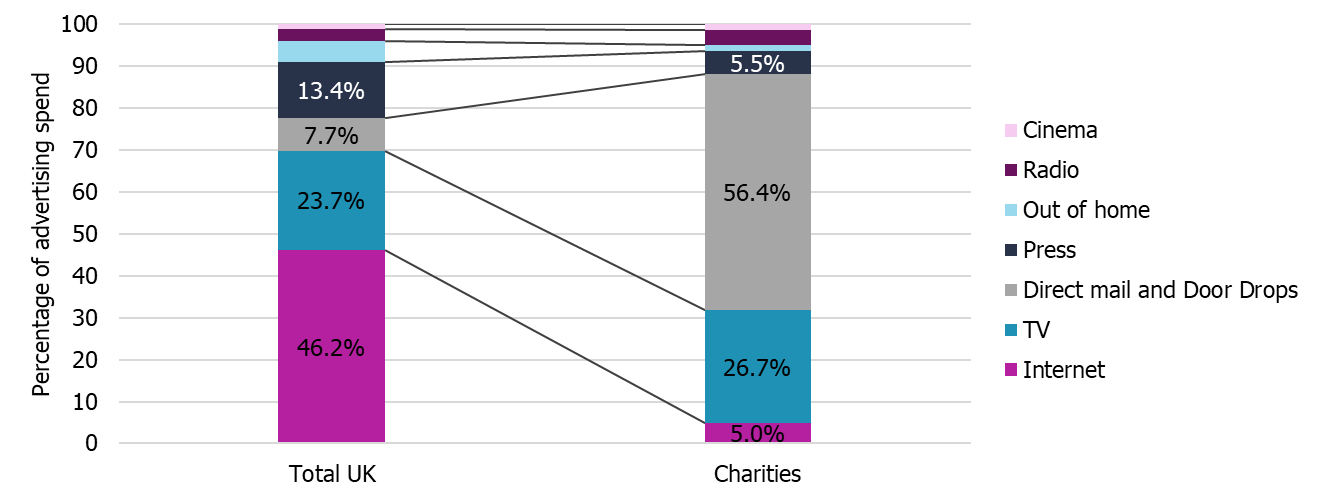The internet is increasingly dominating our time and advertisers are tapping into this. Expenditure across the UK on internet advertising almost doubled from £5.4 billion in 2012 to £10.3 billion in 2016, a huge 46% of all advertising spending. As can be seen in the chart below, charities have not followed the extreme development in this trend with only 5% of their advertising expenditure going on the internet in 2016, up from only 2.5% in 2011.
If 46% of mainstream advertising expenditure is on the internet, why are charities only spending a minimal 5% in this area?
Figure 1: The difference in expenditure of advertising types between mainstream and charity advertisers in 2016

Source: Statista, Advertising Association and Nielsen
One of the main arguments against the investment in internet advertising is the lack of engagement with older audiences – who are also those who state that they give most regularly and the largest amounts to charity[1]. But this is no longer the case! As seen in data from the Office of National Statistics and widely broadcast in the media[2], older generations are increasingly active both online and on social media. The percentage of internet users in older age groups is ever increasing. In 2011, 19.9% of people over the age of 75 used the internet, which has nearly doubled by 2016 up to 38.7%[3]. This trend can only be seen to increase as the never-ending cycle will bring more internet savvy generations into this age group.
The small but significant movement into internet advertising has been spearheaded by mass investment from some of the larger charities. Rapidly increasing their spending from 2014 to 2016, Macmillan has been at the forefront for the last few years. They have increased their advertising spending from £0.65m to £2.9m in just three years, having started their online advertising in 2015 to promote the Macmillan Coffee Morning events[4]. From our research with the general public we can see that this has paid off, resulting in significantly increased awareness. The ability to both reach out broadly, and target advertise through the internet at different cost levels, can provide an opportunity for large and small charities alike to reach existing and new audiences with their campaigns.
As GDPR nears are charities going to shift from direct mail?
Comparably, direct mail has been the staple of charity advertising for decades, and used almost three quarters of advertising expenditure in 2008. This proportion has shrunk in the last 8 years, down to just over half of expenditure in 2016 but this still has huge dominance of charities’ advertising portfolio. With the advent of General Data Protection Regulation (GDPR) and the increasing control over direct correspondence to individuals, this will have to change. This is something we’ve been exploring in both our tracking research and bespoke work to understand and help inform the future of charities’ data protection and contact with their supporters. We have also published a very popular report on GDPR, exploring the public, and specifically donor’s responses to the incoming regulation. As charities change their advertising and fundraising campaigns, perhaps this will provide the right opportunity for charities to diversify their advertising.
As charities reduce the proportion of their spending on direct mail, why are we not seeing an increase on internet advertising spend?
There has been a reduction of spending on direct mail by charities, from three quarters of spend in 2008 to half of advertising cost in 2016. If this was following the trend of the whole of the UK this would have been invested into internet advertising, but instead has moved into a higher proportion being spent on TV advertising. TV advertising has become an increasing cost for charities, almost tripling in the last 8 years to over a quarter of the spend (27%). TV has and does continue to grow and be an important area for advertising, but only within a much larger advertising portfolio. The charity sector could be seen as decades behind the rest of the UK’s advertising scene when looking at the advertising proportions.
Charities are a small but significant part of the advertising scene in the UK. The use of direct mail dominates charities' advertising spending and reflects the desire for individual, targeted campaigns and appeals. However, the lack of investment in internet advertising leaves a gap in charities' portfolios. Especially when this has been so highly successful for the charities that have invested in this area, alongside the success for advertisers in general across the UK. The internet is no longer an exclusive place just for the young and tech savvy, but instead can be a space to engage with individuals across society.
To note on this report:
- All the figures used are from ratecard. Ratecard is the formal amount that an advertiser says it charges for a given space. In practice the actual amount charged may be less, dependent on the scale of media bought, the skill of the media buyer, or if the space has been donated.
- Nielsen’s online estimations for online advertising are limited by their methodology and do not give a completely representative view of the online market such as spending on digital searches or coverage on online sites. This means that the actual amount of spend should be seen as an indices and is most useful in comparison.

